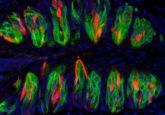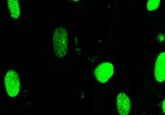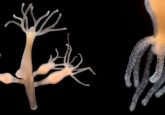Transcription’s origin story

Researchers believe they have found the long-searched-for trigger of all transcription in humans.

Proposed model of DUX4 function during cleavage (1).
A sperm cell punctures an egg cell, and their genetic material merges. For some time afterwards, however, the resulting DNA is relatively silent: genes are not transcribed in fertilized eggs or early embryos, and scientists didn’t know what finally kickstarts this process.
With three studies in Nature Genetics, however, researchers report on one gene that seems to tumble the whole line of dominoes: DUX4. The transcription factor DUX4 is a novel regulator of embryonic genome activation (EGA), also known as zygotic genome activation (ZGA), and scientists hope it could one day be used to help program cells to a totipotent state.
Cleavage and DUX
In non-mammalian species such as Drosophila and Danio rerio, maternal factors trigger the start of transcription in embryos. But no one knew how it begins in humans.
Bradley Cairns at the University of Utah studies totipotency—especially the role of chromatin and epigenetics—using zebrafish. Five years ago, he starting using human cells in his work. His lab has a long-term collaboration with the University of Utah’s in vitro fertilization (IVF) clinic since patients sometimes choose to donate unused embryos to research. Cairns wanted to use those early embryos to determine what drives transcription in the first place, and after a year of completing human subject protocol reviews and ethics requirements, his team began collecting samples of oocytes and very early embryos at various stages of development from the IVF clinic (which took another year). For several months after that, they piloted the genomics.
Finally, Cairns’ team performed a new type of RNA sequencing on the samples, creating a very high-quality library of transcripts. Using principal components analysis (PCA) and cluster analysis, they found that a set of radically different genes were transcribed during the cleavage stage compared to those transcribed before and after.
“It was pretty clear that something very substantial happens during the cleavage stage,” said Cairns. “Our work sets up the mechanistic and conceptual ideas that cleavage is special; it’s there to prepare you for that first developmental decision.”
The cell is still totipotent during the cleavage stage, so the researchers wanted to find the most important transcriptional drivers driving that phase. They found that the binding site for the DUX4 gene was highly enriched upstream of genes specifically expressed during cleavage. Cairns knew that in people with a disease called fascioscapulohumeral muscular dystrophy (FSHD), DUX4 is inappropriately turned on, activating genes and retrotransposons that are usually only turned on in very early embryos. This triggers apoptosis of these muscle cells and, thus, the disease.
But no one knew the normal function of the DUX4 protein. Cairns’ group soon found that if DUX4 was overexpressed in human induced pluripotent stem cells (iPSCs), it activated a significant number of EGA-related genes (but not all of them) and retrotransposons, and made cells look like those from the two-cell stage.
The researchers then turned to mice for functional studies: DUX expression peaked in the two-cell stage in mice, when EGA occurs. When DUX was overexpressed in mouse embryonic stem cells (ESCs), they saw similar changes in gene expression as when DUX4 was overexpressed in human ESCs and iPSCs.
“It was not our intention to work on DUX; we were not familiar with DUX at the outset,” said Cairns. “Our hypothesis was that by acquiring very high quality transcriptomes that span egg development through early embryogenesis, that we would be able to mine those for important transcription factors and chromatin factors that might help drive those processes.”
DUX is the main transcription factor that regulates the retrotransposon MERVL (which triggers a 2-cell-like state). They also found that adding just DUX to mouse ESCs produced a chromatin state that resembles a two-cell-stage embryo.
“This paper establishes that the normal function of DUX is to act as one of the first—if not the first—transcription factors that are turned on in both mouse and human early embryos, and in both cases they only come on for a fraction of one cell cycle and cause what we think is a transcriptional cascade under them. So, we think it’s at the very top of a transcriptional hierarchy,” said Cairns.
Lucky DUX
Didier Trono at the Ecole Polytechnique Federale de Lausanne in Switzerland was working on DUX function as well, intrigued by its role in FSHD. He also found that DUX4 was important for EGA transcription. DUX shines for a brief moment in the life of a mammal, churning out protein for just a few hours at the 2- or 4-cell stage. Then, if all goes well, it’s silent. “It’s probably the gene that’s expressed the shortest time in our life,” said Trono.
Trono and his team used CRISPR/Cas9 to knock out DUX in mouse ESCs, preventing the cells from entering a 2-cell-like state. Furthermore, this prevented the morula/blastocyst stage and induction of MERVL or other typical EGA transcriptional changes. “What made it tricky is that DUX is expressed very early and for a very short time,” he said. “We thus had to delete it very quickly after fertilization of the egg by the sperm.”
While revising his paper, Cairns found out about Trono’s work through a colleague. He contacted him, exchanged some data, and discovered that their findings about DUX aligned. Their papers came out in the same issue of Nature Genetics.
“The papers are completely complementary,” said Cairns. “I really think there’s a ton to do regarding follow-up studies.”
In a third paper in the same issue of Nature Genetics, Stephen Tapscott, a collaborator of Cairns’ at the Fred Hutchinson Cancer Research Center in Seattle, showed differences between the activity of mouse DUX and human DUX4. When mouse DUX was overexpressed in mouse cells, it activated EGA-related retrotransposons, but human DUX4 didn’t.
Tapscott’s work provided initial clues regarding the ancestral derivation of DUX. Ancestral DUX might regulate the transcription of endogenous cleavage-stage genes, but the power of mouse DUX and human DUX4 multiplied when they acquired the ability to regulate retrotransposons that promote cleavage-related gene expression.
The DUX Doesn’t Stop Here
A big question remains: What activates mouse DUX and human DUX4? Perhaps a highly permissive, open chromatin state allows DUX4 to activate to help start EGA. Cairns thinks that DUX4 is epigenetically available during that short period of time, and a maternally inherited transcription factor turns it on. He’s investigating that now.
Understanding how DUX works could improve in-vitro fertilization and help with cloning and cell reprogramming. “It may very well be that there are cases of sterility in humans that are linked to problems in the activation of this gene, and maybe having this knowledge first might help diagnose causes of sterility and also help to improve the efficiency of IVF,” said Trono.
Still, the basic biology itself is riveting. “These are at the very, very root of how life starts; it’s an important piece of information that was missing,” said Trono.





